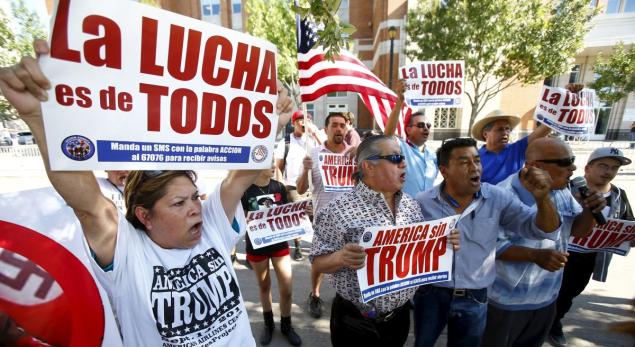
In 2012, Barack Obama defeated Mitt Romney by 5 million votes, receiving 51.1 percent of the total to Romney’s 47.2 percent. This year’s Republican nominee, Donald Trump, has pinned his hopes on a surge of white working-class support for his campaign. But would this be enough to propel him to victory?
On Monday, William H. Frey, a Brookings colleague and one of the country’s leading demographers, examined this hypothesis. One scenario he explored posited a 10-point increase in white working-class turnout coupled with a 10-point increase in Mr. Trump’s margin of victory in this group over the already large advantage Mitt Romney enjoyed in 2012. This scenario also assumed that Mr. Trump would split the white college-educated vote with Hillary Clinton—an optimistic outcome for the Republican nominee in light of the fact that most national and state surveys have shown him trailing significantly among this large and growing portion of the electorate. Even so, Mr. Frey found, Mrs. Clinton would beat Mr. Trump by 2.3 points in the national popular vote, an edge that would virtually guarantee her an Electoral College majority.
In one respect, however, Mr. Frey’s scenario could be more favorable to Hillary Clinton’s chances than the facts on the ground seem to warrant. He assumed that turnout among African Americans would be unchanged from 2012, when it reached a record 66 percent and exceeded white turnout for the first time in history. Both anecdotal evidence from the field and patterns of early voting suggest that without Barack Obama on the ballot, enthusiasm among African Americans has fallen substantially. To what extent would this alter the outcome?
Recent history shows a remarkable rise in African American turnout for presidential elections: 53 percent in 1996, 57 percent in 2000, 60 percent in 2004, and then a huge jump to 65 percent in 2008, followed by an additional point in 2012. It is possible that most of the post-2004 increase reflects the “Obama factor” and that African American turnout in 2016 will more closely resemble 2004. Would this be enough to tip the election?
A scenario in which African American turnout declines from 66 to 60 percent implies a reduction of about 10 percent in this group’s total vote. The following table summarizes the impact this would have on the Democratic vote share in the states that have emerged as keys to the 2016 election, if that reduction in turnout were equal across all states:
| North Carolina | -2.5% |
| Virginia | -1.9 |
| Florida | -1.3 |
| Ohio | -1.3 |
| Michigan | -1.2 |
| Pennsylvania | -1.0 |
| Nevada | -0.8 |
| Wisconsin | -0.7 |
| Arizona | -0.4 |
| Colorado | -0.3 |
| Minnesota | -0.3 |
| New Hampshire | -0.1 |
So as the race is shaping up during its final days, a 10 percent decline in African American turnout could put Trump over the top in three states: North Carolina, Florida, and Ohio. It would not be enough in the rest of Hillary Clinton’s Midwest bastion—Minnesota, Michigan, and Wisconsin—or in Pennsylvania, which was at the top of the Trump campaign’s priorities when the general election began but appears to have slipped down the target list since then.
In a number of key states—Florida, Arizona, and Nevada—the Latino share of the vote is substantially higher than the African American share, meaning an increase of less than 10 percent in Latino turnout would negate the impact of lower African American enthusiasm for the Democratic ticket.
The Latino vote has long failed to meet expectations. Despite Mitt Romney’s support for “self-deportation,” only 48 percent of eligible Latinos voted in 2012. The clash over immigration this year has been central to the Trump campaign’s mobilization strategy among white working-class voters. If the differences between the two major parties in 2016 are not enough to arouse what some regard as the sleeping giant of American politics, it is hard to imagine what would. If it is, Clinton will prevail in Florida and Nevada and come very close in Arizona.
The bottom line: Trump may come close on November 8, but unless he does much better among whites with a college education than recent national and state polls suggest, he will not win 270 electoral votes.
The author wishes to acknowledge the extraordinary research support provided by Mohamad Batal, without whom this article could not have been written.



Expositores: Oscar Vidarte (PUCP) Fernando González Vigil (Universidad del Pacífico) Inscripciones aquí. Leer más
Una retrospectiva para entender los próximos cuatro años. Leer más
En la conferencia se hará una presentación de los temas más relevantes del proceso de negociación se llevó a cabo desde el 2012, así como del acuerdo de paz firmado entre el Gobierno colombiano y la guerrilla de las FARC a finales del 2016. Se analizarán los desafíos y las... Leer más
El Observatorio de las Relaciones Peruano-Norteamericanas (ORPN) de la Universidad del Pacífico es un programa encargado de analizar y difundir información relevante sobre la situación política, económica y social de Estados Unidos y analizar, desde una perspectiva multidisciplinaria, su efecto en las relaciones bilaterales con el Perú.
© 2025 Universidad del Pacífico - Departamento Académico de Humanidades. Todos los derechos reservados.

